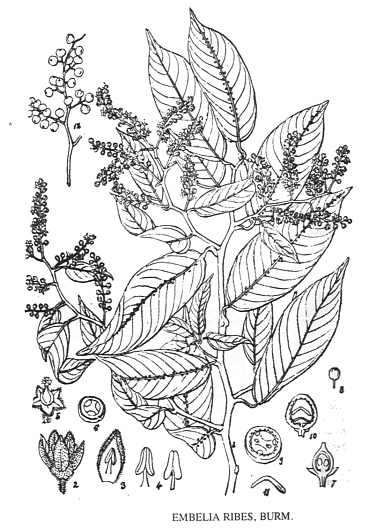

Zitierweise / cite as:
Carakasaṃhitā: Ausgewählte Texte aus der Carakasaṃhitā / übersetzt und erläutert von Alois Payer <1944 - >. -- Anhang A: Pflanzenbeschreibungen. -- Embelia ribes Burm. -- Fassung vom 2007-05-10. -- URL: http://www.payer.de/ayurveda/pflanzen/embelia_ribes.htm
Erstmals publiziert: 2007-03-19
Überarbeitungen: 2007-05-06 [Ergänzungen]; 2007-05-06 [Ergänzungen]
Anlass: Lehrveranstaltung SS 2007
©opyright: Dieser Text steht der Allgemeinheit zur Verfügung. Eine Verwertung in Publikationen, die über übliche Zitate hinausgeht, bedarf der ausdrücklichen Genehmigung des Verfassers
Dieser Text ist Teil der Abteilung Sanskrit von Tüpfli's Global Village Library
WARNUNG: dies ist der Versuch einer
Übersetzung und Interpretation eines altindischen Textes. Es ist keine
medizinische Anleitung. Vor dem Gebrauch aller hier genannten Heilmittel wird
darum ausdrücklich gewarnt. Nur ein erfahrener, gut ausgebildeter ayurvedischer
Arzt kann Verschreibungen und Behandlungen machen!
Falls Sie die diakritischen Zeichen nicht dargestellt bekommen, installieren Sie eine Schrift mit Diakritika wie z.B. Tahoma.
Verwendete und zitierte Werke siehe: http://www.payer.de/ayurveda/caraka0001.htm

Abb.: Embelia ribes Burm.
[Bildquelle: Kirtikar-Basu, ©1918]
Drury:
"Embelia ribes (Burm.) N. 0. Myrsinaceae. Velial, Tam. Vishaul, Mal.. Baberung, Beng.
Description.—Large climbing shrub; tender shoots and peduncles hoary; leaves alternate, oblong, entire, glabrous; panicles terminal, hoary; calyx and corolla 5-parted; stamens inserted in the middle of the petals; flowers numerous, very small, greenish yellow; tube of calyx concave ; berries succulent, black. Fl. Feb.—March.—Wight Icon. t. 1207.—Roxb. Fl. Ind. i, 586.—E. ribesioides, Linn.------Peninsula, Silhet.
Medical Uses.—The natives in the vicinity of Silhet, where the plant grows abundantly, gather the berries, and when dry sell them to the small traders in black pepper, who fraudulently mix them with that spice, which they so resemble as to render it almost impossible to distinguish them by sight or by any other means, as they are withal somewhat spicy. Given in infusion, they are anthelmintic. They are also administered internally in piles. Their pungency is ascribed by Decandolle to the quantity of some peculiar quality of the resinous substance. Royle states they are cathartic. —Don. Royle. Roxb."
[Quelle: Drury, Heber <1819 - 1872>: The useful plants of India : with notices of their chief value in commerce, medicine, and the arts. -- 2d ed. with additions and corrections. London : Allen, 1873. -- xvi, 512 p. ; 22 cm. -- s.v.]
Dutt:
"EMBELIA RIBES, Burm. Sans. Viḍaṅga.
Vern. Bāberang, Hind.Suśruta describes the seeds of Embelia Ribes as anthelmintic, alterative and tonic and recommends their use along with liquorice root for the purpose of strengthening the body and preventing the effects of age. Later writers regard bāberang as carminative stomachic, anthelmintic and useful in intestinal worms, dyspepsia, and skin diseases.
For expelling intestinal worms, the powder of the seeds is given in drachm doses with honey, or with an infusion of the seeds. A compound powder and a ghrita are also prepared by the addition of various other drugs.
Bāberang enters into the composition of several applications for ringworm and other skin diseases. The following is an example. Take of bāberang, rock salt, chebulic myrobalan, bakuchi, mustard, turmeric and the seeds of Pongamia glabra (karanja), equal parts and make them into a thin paste with cow's urine."
[Quelle: Dutt, Uday Chand: The materia medica of the Hindus / Uday Chand Dutt. With a glossary of Indian plants by George King. -- 2. ed. with additions and alterations / by Binod Lall Sen & Ashutosh Sen. -- Calcutta, 1900. - XVIII, 356 S. -- S. 187f.]